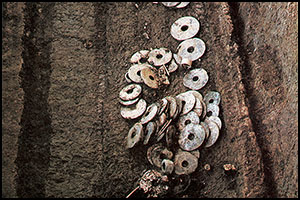Crossref Citations
This article has been cited by the following publications. This list is generated based on data provided by
Crossref.
2019.
ANNUAL BIBLIOGRAPHY.
Early China,
Vol. 42,
Issue. ,
p.
347.
Qin, Ling
and
Fuller, Dorian Q.
2019.
Prehistoric Maritime Cultures and Seafaring in East Asia.
Vol. 1,
Issue. ,
p.
159.
Feinman, Gary M.
Fang, Hui
and
Nicholas, Linda M.
2019.
Coastal Shandong, China: The longue durée.
Journal of Anthropological Archaeology,
Vol. 55,
Issue. ,
p.
101076.
Zhang, Chi
Pollard, A. Mark
Rawson, Jessica
Huan, Limin
Liu, Ruiliang
and
Tang, Xiaojia
2019.
China's major Late Neolithic centres and the rise of Erlitou.
Antiquity,
Vol. 93,
Issue. 369,
p.
588.
Zhang, Liangren
2019.
Encyclopedia of Global Archaeology.
p.
1.
Leppard, Thomas P.
2019.
Social Complexity and Social Inequality in the Prehistoric Mediterranean.
Current Anthropology,
Vol. 60,
Issue. 3,
p.
283.
Innes, James B.
Zong, Yongqiang
Xiong, Haixian
Wang, Zhanghua
and
Chen, Zhongyuan
2019.
Pollen and non-pollen palynomorph analyses of Upper Holocene sediments from Dianshan, Yangtze coastal lowlands, China: Hydrology, vegetation history and human activity.
Palaeogeography, Palaeoclimatology, Palaeoecology,
Vol. 523,
Issue. ,
p.
30.
Jin, Yuxiang
Mo, Duowen
Li, Yiyin
Ding, Pin
Zong, Yongqiang
and
Zhuang, Yijie
2019.
Ecology and hydrology of early rice farming: geoarchaeological and palaeo-ecological evidence from the Late Holocene paddy field site at Maoshan, the Lower Yangtze.
Archaeological and Anthropological Sciences,
Vol. 11,
Issue. 5,
p.
1851.
Zhang, Liangren
2020.
Encyclopedia of Global Archaeology.
p.
2294.
Wang, Ningyuan
Dong, Chuanwan
Xu, Honggen
and
Zhuang, Yijie
2020.
Letting the stones speak: An interdisciplinary survey of stone collection and construction at Liangzhu City, prehistoric Lower Yangtze River.
Geoarchaeology,
Vol. 35,
Issue. 5,
p.
625.
Dong, Ningning
and
Yuan, Jing
2020.
Rethinking pig domestication in China: regional trajectories in central China and the Lower Yangtze Valley.
Antiquity,
Vol. 94,
Issue. 376,
p.
864.
Hawkes, Jason D.
and
Casile, Anne
2020.
Back to basics: returning to the evidence and mapping knowledge in south Asian archaeology.
Asian Archaeology,
Vol. 3,
Issue. 1-2,
p.
95.
Fuller, Dorian Q.
2020.
Transitions in Productivity: Rice Intensification from Domestication to Urbanisation.
Archaeology International,
Vol. 23,
Issue. 1,
Higham, Charles F.W.
2021.
The later prehistory of Southeast Asia and southern China: the impact of exchange, farming and metallurgy.
Asian Archaeology,
Vol. 4,
Issue. 2,
p.
63.
Staff, Richard A.
and
Liu, Ruiliang
2021.
Radiocarbon calibration: The next generation.
Science China Earth Sciences,
Vol. 64,
Issue. 3,
p.
507.
OKAZAKI, KENJI
TAKAMUKU, HIROFUMI
KAWAKUBO, YOSHINORI
HUDSON, MARK
and
CHEN, JIE
2021.
Cranial morphometric analysis of early wet-rice farmers in the Yangtze River Delta of China.
Anthropological Science,
Vol. 129,
Issue. 2,
p.
203.
He, Keyang
Lu, Houyuan
Sun, Guoping
Ji, Xiang
Wang, Yonglei
Yan, Kaikai
Zuo, Xinxin
Zhang, Jiangping
Liu, Bin
and
Wang, Ningyuan
2021.
Multi-proxy evidence of environmental change related to collapse of the Liangzhu Culture in the Yangtze Delta, China.
Science China Earth Sciences,
Vol. 64,
Issue. 6,
p.
890.
Li, Tao
Yao, Shuai
He, Limin
Yu, Xiyun
and
Shan, Siwei
2021.
Compositional study of household ceramic assemblages from a Late Neolithic (5300–4500 cal BP) earthen walled-town in the middle Yangtze River valley of China.
Journal of Archaeological Science: Reports,
Vol. 39,
Issue. ,
p.
103159.
Yu, Xueer
and
Li, Hui
2021.
Origin of ethnic groups, linguistic families, and civilizations in China viewed from the Y chromosome.
Molecular Genetics and Genomics,
Vol. 296,
Issue. 4,
p.
783.
Jaffe, Yitzchak Y.
Castellano, Lorenzo
Shelach-Lavi, Gideon
and
Campbell, Roderick B.
2021.
Mismatches of scale in the application of paleoclimatic research to Chinese archaeology.
Quaternary Research,
Vol. 99,
Issue. ,
p.
14.



